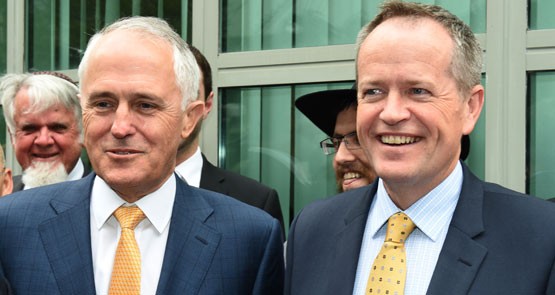
As the wheel of federal politics begins to turn again after the interruption of the festive season, all calculations for the year ahead are hostage to one overriding question: when and how Malcolm Turnbull will place his prime ministership before the verdict of the voters.
Broadly speaking, two options are available in calling an election that could, in theory, be delayed as late as January 14 next year, but will assuredly be held much sooner.
The first is to go early with a double dissolution, for which triggers are available in the form of twice-rejected bills to abolish the Clean Energy Finance Corporation, and to impose greater oversight on union officials.
While the latter issue has potential as a means of attacking Labor over union corruption, the real attraction of the double dissolution option comes down to election timing.
The earliest possible date for a vanilla-flavoured election for the House of Representatives and half the Senate is August 6, since the election to replace the senators elected in 2010 cannot be called until the final year of a term that runs to mid-2017.
Given the extremely difficult budget the government will have to bring down in May, the Liberals have good cause to fear that much of Turnbull’s current gloss will have worn off by then. Turnbull also has the fractious state of his party to think about, and could well feel that he has the opportunity to marginalise his internal critics if he gets in quick with a decisive win over Labor while his stocks are still at their height.
The optimal time for such an election would be in early or mid-March, given the interruption of Easter holidays later that month, and the need for breathing space between the election and the budget session of Parliament.
So if Turnbull indeed has a double dissolution in mind, we should know about it fairly soon. However, there are two reasons to doubt that things are headed in that direction.
First, senators elected at a double dissolution would have the start of their terms backdated all the way to the middle of last year, so that Turnbull would effectively be committing himself to a further election of one kind or another barely more than two years later.
The second issue relates to the still-unreformed Senate electoral system, which could hardly fail to return a bumper crop of micro-party chancers under the lower quota for election that applies at a double dissolution.
It is well and truly too late now to reform the system in time for an election held before the May budget.
The government’s relaxed approach suggests either that it has no real intention of changing the system in the short term, or that it will play its hand as late in the game as it can get away with, so as to avoid alienating the crossbench any earlier than necessary.
The latter possibility presumes that Turnbull will exercise the second of the two options available to him: a normal election in the second half of the year.
While such an election could in theory be held in early August, conventional wisdom holds that voters can be caught in a happier mood at an election held between September and March.
Further obstacles to election timing loom in late September and early October, with school holidays to be in swing everywhere other than South Australia and the Northern Territory by September 24.
The weekend that follows is particularly off-limits, since it coincides with the AFL and NRL grand finals.
The government will, in any case, have passed its third year anniversary by that time, and hanging on too long beyond that is generally held to be poor form.
The case for September is further strengthened by the other two electoral events in store for the year: elections for the Northern Territory and the Australian Capital Territory.
The territories’ respective electoral laws set polling day for August 27 in the NT and October 15 in the ACT, but they also provide for the dates to be rescheduled should the Prime Minister be rude enough to call an election of his own for the same day.
In that case, the ACT election would be delayed until January, while the NT election would be rescheduled for an alternative date two months earlier or later.
Taking all the other considerations into account, Turnbull has little reason to offend local sentiment by following such a course.
Very likely he spoke truly when he said he was “expecting” the election would be held in September or October — by which he most probably meant September 3, 10 or 17, or perhaps October 8 at a pinch.








Whenever he goes Turnbull has a winner in the issue of the public’ belief there’s a need to impose greater oversight on union officials.
Perhaps that’s why the usual suspect Crikey-philes aren’t venturing on to this thread?
As far as your last paragraph is concerned, I hope you are correct. By that time even those with half a brain should have been able to work out that Talcum Malcum is just Tony Abbott in a more expensive suit!!
@nh.. It’s such a winner that the report got thrown out with the trash when no one was paying attention..the only interest in this report is the redacted section and the only real scandal is the millions wasted on an inquiry that should have been held into phoenixing ..
Unless PM Turnbull wants to lose a Minister [Sussan Ley] or buy a brawl with the Nationals, or both, he will not hold an election in March. The Writs would have to be issued before the NSW redistribution is finalised on 25 February 2016. The seats of Farrer and Riverina would have to be combined to ensure that 47 seats are in place. WA’s new boundaries with the extra seat, are finalised. The earliest date for an election with new NSW boundaries would be 2 April. Turnbull would not be concerned that Easter is the week before. He could also select april 9 or 16.
Thanks to Bill, & JohnA@4, for such erudite & thoughtful material.
I’m going to have to chew it over again but methinks (nod to theJames)late April.
Perhaps Autumn when the olde worlde begins to die off?